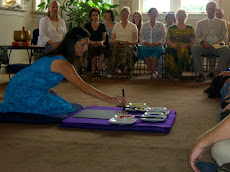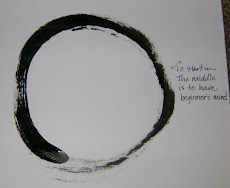Today, in an attempt to guide my students on their way to successful writing, we made sandwiches in Language Arts. Well, two students made sandwiches while the rest of the class watched.*
"Sandwiches," you ask?! "How do sandwiches and writing have any correlation whatsoever?"
I'm glad you asked.
I actually borrowed and tweaked the idea from Erin Gruwell's The Freedom Writers Diary Teacher's Guide. To help her students understand what "ingredients" make up good writing, she used sandwiches as a metaphor. It's a good metaphor.
So I had two students come up to the front of the class and join me at a table I had set up. One half of the table was covered with a pretty blue-patterned table cloth, the other was bare. The tablecloth side contained a real plate, a cloth napkin, and a real knife. These were flanked by two candles (which I allowed the students to light), condiments, two kinds of deli meats, two kinds of cheeses, lettuce and tomato. The uncovered half of the table had a paper plate and paper napkin and a package of Oscar Mayer turkey.
Each student was given two slices of bread. The student at the uncovered half of the table received white bread. The student at the covered half of the table received 12-Grain. They were then both asked to make a sandwich using the ingredients on their half of the table.
I imagine that you can imagine both sides' outcomes.
After cutting both sandwiches in half, exposing the "insides" of each, I had the students hold their sandwiches up for the rest of the class to see. "Which one looks more inviting?,"I asked. "Which one has more colors? Tell me what you know about bread...What are the characteristics of a tomato? What do you think of when you think of lettuce?"
Following this discussion, I passed out menus. And here, you need a little bit of background information:
For the past few weeks we have been studying ancient Greece in Social Studies and concurrently we have been reading Greek mythology in Language Arts. We have also read some of Aesop's Fables and, last week, my students wrote their own fables.
The menus I passed out were for a fictitious Language Arts restaurant called Aesop's Tables (est. 2009, with my first class of sixth graders). At Aesop's Tables patrons can begin with "Starters." Highly recommended is a slice of bread, also known as the introduction. On a sandwich, the bread is the first thing your mouth tastes, so you want it to be good. The same is true of the opening paragraph in your writing.
After "Starters" we move onto the "Fixings" - everything in between: the meat, the body of the piece (characters and events); the cheese, which enriches the writing (themes and images), tomatoes, the specific and juicy details (adjectives, adjectives!), and the lettuce - which gives the piece a crisp, clean writing style (grammar, punctuation - structure). The Piece de Resistance: "Desert," of course! The second piece of bread: the conclusion.
I then explained to my students that we were going to use their newly written fables as a foundation to begin our writing. Most all of my students have been taught how to write paragraphs before, however, not many of them really learned how. Like everything, writing is a process. And herein lies the paradox.
I am a teacher. However I am a student. That is very clear. I teach sixth grade at a charter school in Tempe, Arizona. I am also a graduate student at Naropa University, located in Boulder, Colorado. But while I am teaching, I am also learning - from my students, from myself - I am always making new discoveries, always seeing things I didn't see before, or understanding things from a new and different perspective. This happens daily. Some days are more, "Wow! I could've had a V-8!" than others. Today was a "Wow! I could've had a V-8!" day.
Last night I completed the second draft of my thesis proposal. Today, I offered my students a beginning lesson in writing, but I really think the person who could benefit from that lesson most - at least right now - is me! I'm all fired up about re-looking at and re-thinking the writing of my thesis project. And that's a good thing. But I am going to wait one more day to look at it again. Just like today gave me a new perspective, I believe having another day away from what I finished last night, might be more beneficial. Distance and space often allow one to look more closely and see more clearly. But that is a paradox for another day.
*I brought doughnut holes for all of the students, by the way. If you are an elementary or middle school teacher, you know that you cannot bring food into a classroom unless you feed the masses. If you don't, they start rioting (if you do not teach middle school or elementary school - I am not kidding!).
Lizard Coloring Page
2 years ago





No comments:
Post a Comment